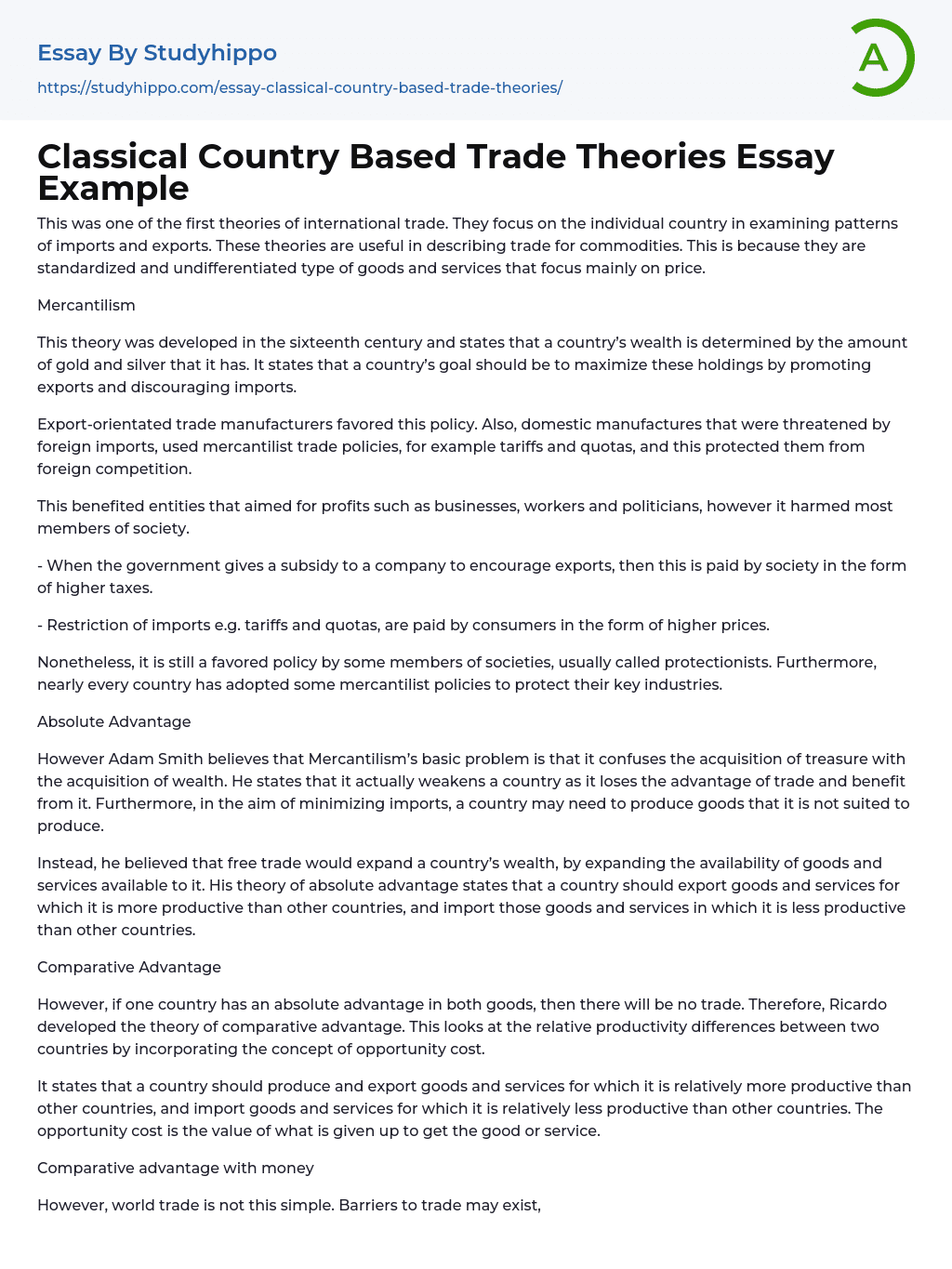This was one of the first theories of international trade. They focus on the individual country in examining patterns of imports and exports. These theories are useful in describing trade for commodities. This is because they are standardized and undifferentiated type of goods and services that focus mainly on price.
Mercantilism
This theory was developed in the sixteenth century and states that a country’s wealth is determined by the amount of gold and silver that it has. It states that a country’s goal should be to maximize these holdings by promoting exports and discouraging imports.
Export-orientated trade manufacturers favored this policy. Also, domestic manufactures that were threatened by foreign imports, used mercantilist trade policies, for example tariffs and quotas, and this protected them from foreign competition.
This benefite
...d entities that aimed for profits such as businesses, workers and politicians, however it harmed most members of society.
- When the government gives a subsidy to a company to encourage exports, then this is paid by society in the form of higher taxes.
- Restriction of imports e.g. tariffs and quotas, are paid by consumers in the form of higher prices.
Nonetheless, it is still a favored policy by some members of societies, usually called protectionists. Furthermore, nearly every country has adopted some mercantilist policies to protect their key industries.
Absolute Advantage
However Adam Smith believes that Mercantilism’s basic problem is that it confuses the acquisition of treasure with the acquisition of wealth. He states that it actually weakens a country as it loses the advantage of trade and benefit from it. Furthermore, in the ai
of minimizing imports, a country may need to produce goods that it is not suited to produce.
Instead, he believed that free trade would expand a country’s wealth, by expanding the availability of goods and services available to it. His theory of absolute advantage states that a country should export goods and services for which it is more productive than other countries, and import those goods and services in which it is less productive than other countries.
Comparative Advantage
However, if one country has an absolute advantage in both goods, then there will be no trade. Therefore, Ricardo developed the theory of comparative advantage. This looks at the relative productivity differences between two countries by incorporating the concept of opportunity cost.
It states that a country should produce and export goods and services for which it is relatively more productive than other countries, and import goods and services for which it is relatively less productive than other countries. The opportunity cost is the value of what is given up to get the good or service.
Comparative advantage with money
However, world trade is not this simple. Barriers to trade may exist, and many different inputs are necessary to produce goods. The theory of comparative advantage with money incorporates this medium of exchange into the discussion of trade. In this situation, a country will aim to buy goods from other another country at the lowest cost.
Relative Factor Endowments (Heckscher-Ohlin Theory)
This theory determines the products for which a country has a comparative advantage. It includes 2 basic observations:
1) Factor endowments (types of resources) vary among
countries.
2) Goods differ according to the types of factors that are used to produce them.
Their theory is, a country will have a comparative advantage in producing products that intensively use resources that it has in abundance.
However, Leontief found a flaw in the theory. Leontief conducted research and found that US imports were more capital intensive that exports. However, he did find out what explained this paradox. It was later found that Leontief assumed that there were only 2 homogenous F.O.P: labor and capital. Leontief’s failure to take into account how other factors of production take part in Intl’ trade patterns may explain how he got his paradoxical results.
- American Dream essays
- Barriers To Entry essays
- Capitalism essays
- Central Bank essays
- Compensation essays
- Consumerism essays
- Economic Development essays
- Economic Growth essays
- Economic Inequality essays
- Economic System essays
- Economy essays
- Employment essays
- Export essays
- Finance essays
- Free Trade essays
- Gross Domestic Product essays
- Human Development essays
- Income Inequality essays
- Industry essays
- Inflation essays
- International Business essays
- International Trade essays
- Macroeconomics essays
- Materialism essays
- Max Weber essays
- Microeconomics essays
- Minimum Wage essays
- Monetary Policy essays
- Monopoly essays
- Pricing essays
- Profit essays
- Recession essays
- resources essays
- Taxation essays
- Trade essays
- Unemployment essays
- Warehouse essays
- World economy essays




